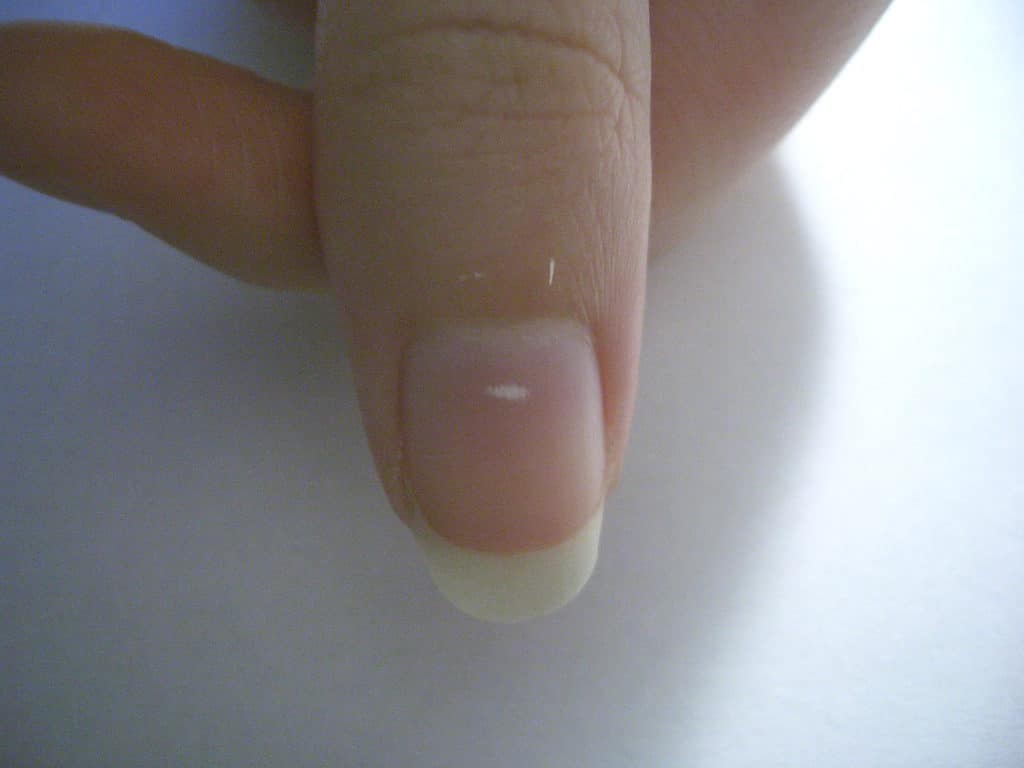They say nails can tell you a lot about someone’s personality. That’s mostly a myth, but nails do say a lot about a person’s hygiene, character, and have even become a way of expressing art. Nails are also a sign of our evolutionary heritage and most importantly, they serve as a protective barrier that helps keep viruses and bacteria away.
But there’s something else our nails can do for us: they can serve as an indicator for some mineral deficiencies and other health issues. White spots on fingernails can be indicative of insufficient zinc, in rarer cases, they can also be a sign of eczema, health conditions, or even poisoning. But there are also a lot of myths regarding these white spots on your nails, and the most common one is probably not what you think.

A clue on our hands
Human fingernails and toenails are typically pale pink, featuring a half-moon-shaped white part at the root, known as a lunula. The lunula is also white-ish, but this isn’t the type of white spot we’re talking about.
When white spots or flecks appear on the nail, they’re called punctate leukonychia (leuko means white, onyx means nail).
From time to time, you may notice teeny tiny white flecks, although they can go unnoticed at first glance. It has become a common misconception that these spots are indicative of calcium or zinc deficiency. However, there are several types of leukonychia, and by far, the most common case is trauma — not a mineral deficiency.
The white spots are typically caused by a trauma indicative of damage to the nail bed or to the pinkish-colored soft tissue beneath the nail plate (the hard part of the nail). The bruising may have been caused by knocking the finger against the door or another hard surface and even nail biting. The spots will generally disappear as the nail grows and should completely disappear in about 8 months.
This type of nail trauma can come from surprising things. Even biting your nails can cause them (you really shouldn’t do that), as can getting a manicure.
Excessively getting manicures can also do more harm than good as it can injure the nail matrix resulting in these white spots. Using nails as a canvas for art is pretty cool, but making sure your manicure is healthy is also very important. Frequent use of polish can chemically damage the nails leading to discoloration and weaken the nail plate, and some nail polishes can be toxic. In turn, this does not make it very effective protection for the tissue underneath making it more susceptible to bruising and may cause delayed healing. So if you are getting your nails done and have noticed white spots on them, it may be important to tell your manicurist.
Other than trauma, what causes white spots on the nails?
Medical experts do not dismiss the idea that leukonychia is caused by mineral deficiencies but this is only a rare case. Basically, this seems to be the exception more than a rule. However, this is not an excuse to simply ignore the white spots, especially if you get them regularly. If you have no reason to suspect any trauma and are noticing recurring white spots, it may be wise to pay more attention to them.
Other common causes of white spots on nails:
- excess (careless) manicures;
- fungal infection;
- mineral deficiency (most likely zinc);
- certain medications or treatments;
- heavy metal poisoning;
- kidney failure.
As mentioned, you shouldn’t be alarmed if you see these white spots on your nails. But if you’re certain it’s not trauma, it may pay to investigate with your doctor or dermatologist. If you see them on your feet but not on your hands, for instance, there’s a chance that it could be linked to a fungal infection (since feed sweat more than hands and it’s harder for the skin to breathe).
If you’re taking (or about to take) some serious medication, it’s worth checking if this could be a side effect to the treatment. Even if it is, white spots are harmless and should not be a reason to stop any necessary treatment.
If you do suspect a mineral deficiency, you shouldn’t first jump to vitamins or supplements, but rather pay a bit more attention to your diet. Nails are made of protein and one way to care for them is to add more protein to your daily intake. Dark green leafy vegetables and fruits that are rich in antioxidants are also helpful in helping the nail grow and heal faster.
In certain instances, the white specks on nails could also be a sign of heart disease, kidney failure, psoriasis, or pneumonia. It can also be brought on by allergic reactions to certain chemicals, fungal infections or the side effects of medications. If these spots become persistent and get worse, it is time to seek medical advice as it may be a sign of something serious — but these instances are very rare.
Another type of white spot on nails is called longitudinal leukonychia, and, as the name implies, these are longitudinal features instead of specky spots. These are much rarer and may be associated with Darier’s disease. This is sometimes not considered to be “true” leukonychia.
Leukonychia punctata is a common problem, and in the vast majority of cases, a completely harmless one. They are usually not related to any health conditions and should not cause any concern. However, if you do see them popping up recurrently, it wouldn’t hurt to ask your medic about them.
Nails are not just there for beautification purposes. In fact they come with a greater purpose. Taking care of them goes beyond just getting a regular spa session with a manicure or pedicure. To get to the core of having healthy-looking nails, eating a healthy balanced diet plus avoiding bad habits such as nail biting is the best thing you can do to make your nails happy.




